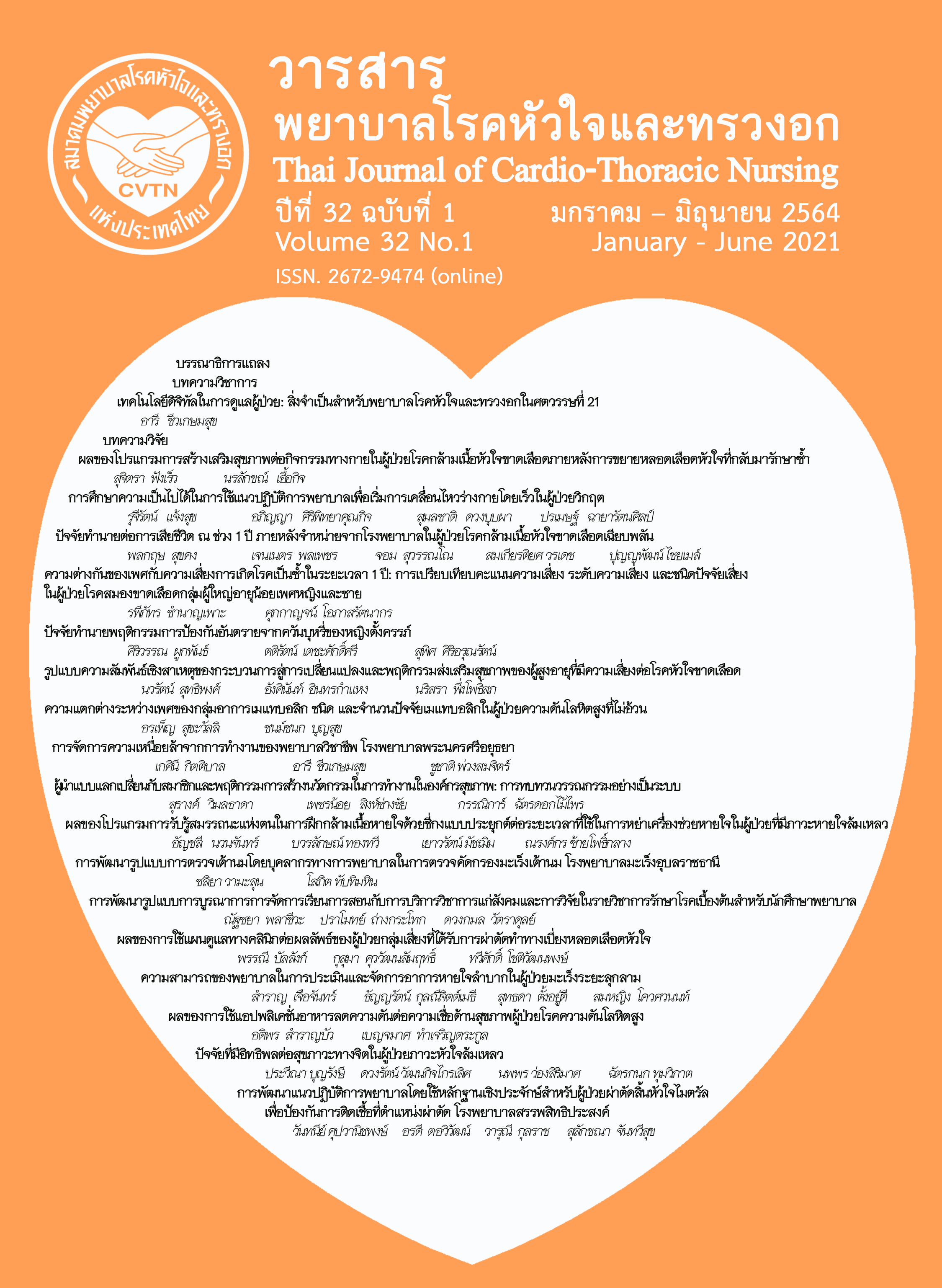Predictors of mortality at one - year after hospital discharge among patients with acute coronary syndrome
Keywords:
Acute coronary syndrome, GRACE risk score, mortalityAbstract
This retrospective cohort study aimed to examine the predictors for one-year mortality after hospital discharge among patient with ACS. Eligible samples were a total of 187 ACS patients. Reviews of annual medical records were conducted for data collection. Global Registry of Acute Coronary Events (GRACE) risk score was used to assess and stratify risk level for mortality prediction. Descriptive and Cox proportional hazard model statistics were used to analyze descriptive data and predictors for one-year mortality after hospital discharge, respectively.
Results showed that most of the patients in this study were male (68.45 %), an average age of 66.22 ± 15.80 years. The prevalence rate of mortality was 14.97 % at one-year after hospital discharge. High level of GRACE risk score predicts mortality HR= 6.98 (95%CI: 1.58-30.79; p= 0.010). Multi-factors analysis with mortality, presented that high cardiac enzyme level, previous heart failure history, cardiac arrest, and high risk level of GRACE risk score, were significant to predict mortality that were adjusted HR 9.13 (95%CI: 1.18-70.75; p= 0.034), adjusted HR 2.74 (95%CI: 1.03-7.32; p= 0.043), adjust HR= 4.37 (95%CI: 1.57-12.17; p= 0.005), and adjusted HR= 2.59 (95%CI: 1.08-6.22; p= 0.033, respectively).
The findings of this study are deeply concerned that the GRACE risk score should be applied to stratify the risk level of mortality in patient with ACS. Patient with ACS who have high risk level of GRACE risk score, high cardiac enzyme level, previous heart failure history, and cardiac arrest should receive specific and continuing care after hospital discharge for preventing mortality.
References
World Health Organization. Global health estimates 2016: Deaths by cause, age, sex, by country and by region, 2000- 2016 Geneva, Switzerland 2018-. [cited 2019 Nov 16]. Available from http://www.who.int/healthinfo/global_burden_disease/estimates/.
Vedanthan R, Seligman B, Fuster V. Global perspective on acute coronary ayndrome: a burden on the young and poor. Circ Res. 2014; 6:1959-75.
Radovanovica D, Urban P, Simonc R, Schmidli M, Maggiorinie M, Rickli H, et al. Outcome of patients with acute coronary syndrome in hospitals of different sizes. Swiss Med WKLY. 2010;140(21–22):314–22.
Pocock S, Bueno H, Licour M, Medina J, Zhang L, Annemans L, et al. Predictors of one-year mortality at hospital discharge after acute coronary syndromes: A new risk score from the EPICOR (long-tErm follow uP of antithrombotic management patterns In acute CORonary syndrome patients) study Eur Heart J Acute Cardiovasc Care. 2014:1-9.
Suwanno J, Chauychu B, Pholphet C. Association of risk level and major adverse cardiovascular events in patients with non-ST elevation myocardial infarction: a clinical assessment using GRACE risk score. Thai Journal of Cardio-Thoracic Nursing. 2018;29(1): 17-28. (in Thai).
Srimahachota S, Boonyaratavej S, Kanjanavanit R, Sritara P, Krittayaphong R, Kunjara-Na-Ayudhya R, et al. Thai registry in acute coronary syndrome (TRACS) an extension of Thai acute coronary syndrome registry (TACS) Group: Lower in-hospital but still high mortality at one-year. J Med Assoc Thai. 2012;95(4):508-18.
Yan AT, Yan RT, Tan M., Eagle KA, Granger CB, Dabbous OH, et al. In-hospital revascularization and one-year outcome of acute coronary syndrome: Patients stratified by the GRACE Risk Score. Am J Cardiol. 2005;96(7):913-16.
Goncalves PA, Ferreira J, Aguiar C, Seabra-Gomes S. TIMI, PURSUIT, and GRACE risk scores: sustained prognostic value and interaction with Revascularization in NSTE-ACS. Eur Heart J. 2005; 26:865-72.
Fox KAA, Eagle KA, Gore JM, Steg PG, Anderson FA. The Global Registry of Acute Coronary Events 1999 to 2009-GRACE. Heart. 2010;96(14):1095-101.
Eagle KA, Lim MJ, Dabbous OH, Pieper KS, Goldberg RJ, Werf FV, et al. A validate prediction model of forms acute coronary syndrome. JAMA. 2004;291(22):2727-33.
Goldberg RJ, Currie K, White K, Brieger D, Stey PG, Goodman SG, et al. Six-month outcomes in a multinational registry of patients hospitalized with an acute coronary syndrome (The Global Registry of Acute Coronary Events [GRACE]). Am J Cardiol. 2004;93(3):288-293.
Wang OJ, Wang Y, Chen J, Krumholz HM. Recent trends in hospitalization for acute myocardial infarction. Am J Cardiol. 2012;109:1589-93.
Tang EW, Wong CK, Herbison P. Global Registry of Acute Coronary Events (GRACE) hospital discharge risk score accurately predicts long-term mortality post acute coronary syndrome. Am Heart J. 2007;153(1):29-35.
Granger CB, Goldberg RJ, Dabbous O, Pieper KS, Eagle KA, Cannon CP, et al. Predictors of hospital mortality in the Global Registry of Acute Coronary Events. Arch Intern Med. 2003;63(19):2345-2353.
Tang EW, Wong C, Herbison P. Global Registry of Acute Coronary Events (GRACE) hospital discharge risk score accurately predicts long-term mortality post acute coronary syndrome. Am Heart J. 2007;153(1):29-35.
Fox KAA, Dobbous OH, Goldberg RJ, Pieper KS, Eagle KA, Van de Werf F, et al. Prediction of risk of death and myocardial infarction in the six months after presentation with acute coronary syndrome: Prospective multinational observational study (GRACE). BMJ. 2006; 333:1091-94.
Boersma E, Pieper KS, Steyerberg EW, Wilcox RG, Chang W, Lee K, et al. Predictors of outcome in patients with acute coronary syndromes without persistent ST-segment elevation: Results from an international trial of 9461 patients. Circulation. 2000,101(22): 2557-67.
Newby LK, Bhapkar MV, White HD, Topol EJ, Dougherty FC, Harrington RA. Predictors of 90-day outcome in patients stabilized after acute coronary syndrome. Eur. Heart. J. 2003;24(2):172-81.
Terkelsen CJ, Lassen JF, Norgaard BL, Gerdes JC, Jensen T, Gotzsche LBH, et al. Mortality rates in patients with ST-elevation vs. non-ST-elevation acute myocardial infarction: observations from an unselected cohort. Eur. Heart. J. 2005; 26:18–26.
Abu-Assi E, García-Acuña JM, Peña-Gil C, González-Juanatey JR. Validation of the GRACE risk score for predicting death within 6 months of follow-up in a contemporary cohort of patients with acute coronary syndrome. Rev Esp Cardiol. 2010;63(6):640-8.
Chan MY, Shah BR, Gao F, Sim LL, Chua T, Tan CH, et al. Recalibration of the Global Registry of Acute Coronary Events risk score in a multiethnic Asian population. Am Heart J. 2011;162(2): 291-99.
Downloads
Published
How to Cite
Issue
Section
License
บทความนี้ยังไม่เคยตีพิมพ์หรืออยู่ในระหว่างส่งไปตีพิมพ์ในวารสารอื่น ๆ มาก่อน และกองบรรณาธิการขอสงวนสิทธิ์ในการตรวจทาน และแก้ไขต้นฉบับตามเกณฑ์ของวารสาร ในกรณีที่เรื่องของท่านได้ได้รับการตีพิมพ์ในวารสารฉบับนี้ถือว่าเป็น ลิขสิทธิ์ของวารสารพยาบาลโรคหัวใจและทรวงอก






